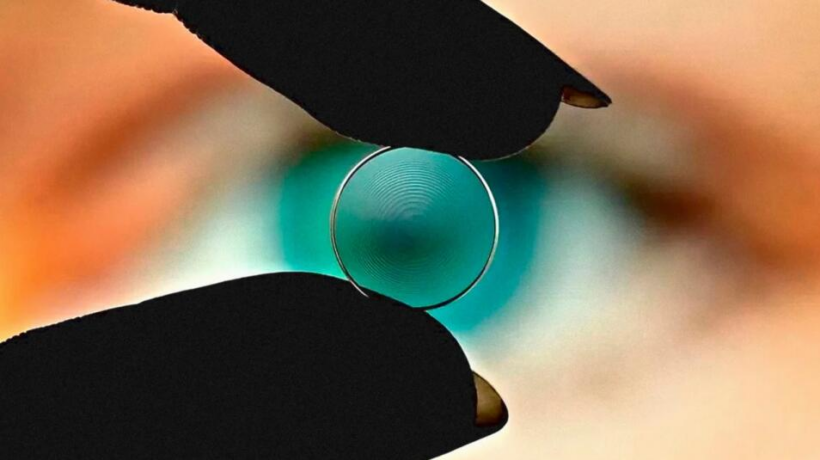If you wear eyeglasses or contact lenses, this might sound like a sci-fi dream come true: Researchers have designed a new spiral-shaped optical lens that can fix your sight. No matter the distance, or your prescription, everything in front of you will be totally in focus.
But this is no dream device. According to a research paper just published in the peer-reviewed scientific journal Optica, these lenses are very real. They are the invention of Laurent Galinier, an optometrist who developed an acuity measurement system that he sold to the international optical giant Essilor in 2000. Galinier got into a series of ventures after that and, while working on contact lenses for patients with corneal pathologies, his intuition made him stumble upon this extraordinary discovery.
“Remarkably, he observed that certain deformations brought about specific focusing characteristics,” Bertrand Simon, one of the paper’s coauthors, explains over email. “This led him to devise spiraling the diopter [the measurement that represents the optical strength of a lens] of the lenses to achieve multi-focusing.”
Translated: Galinier developed a spiraling contact lens that could replace progressive lenses.
HOW THE SPIRAL MAGIC WORKS
Simon explains that the spiral lenses are created by reshaping the surface of a polymer to generate optical vortices that have distinct focusing properties. Think about these vortices as water swirls that capture light rays and make them “spin.” As the rays spin through the spiral, they form different focal points where the light concentrates. These focal points have the ability to correct your vision problems making everything look in focus, even as the distance of what you’re looking at changes.
In conventional optics, light rays travel along straight paths, changing direction as they go through lenses to make objects look bigger or smaller, correcting their focus at specific distances. This is how your current glasses, binoculars, and cameras work.
Traditional progressive lenses suffer from distortions as you move your eyes up or down to focus on things that are far away or near. This new lens doesn’t suffer from such deformations. Things are always on focus, continuously, the researchers say. This is a key advantage, particularly for those with age-related farsightedness or potential implant users.
The technology has wide potential applications, Simon tells me. It can be used in contact lens technologies, intraocular implants for cataract surgery, other retinopathies, and miniaturized imaging systems, from cameras in phones to drones. Even regular glasses can use this effect, although Simon admits that the spiral shape—which will be partially visible on the glasses—may deter people from wanting to.
In theory, once the technology goes through successful patient trials validation, these lenses would replace the current lineup of progressive lenses, Simon says. So far, early volunteer trials have shown promising results. “Volunteers have shown noticeable improvements in visual acuity at various distances and lighting conditions,” he says.
EXTRAORDINARY POTENTIAL
At the moment, the spiral lenses can correct accommodation defects (a condition that makes your eye lose focus), myopia (a common eye problem where objects far away look blurry), and hypermetropia (the opposite of myopia). “We can also incorporate multiple corrections in one lens,” Simon says. The team has yet to prove the lens’ efficacy in cases of astigmatism, which is one of the most common ocular aberrations, but they’re working on it.
When I asked about the lens’ ability to solve for a macular problem that caused a deformation on my left eye’s retina (imagine seeing the world through Photoshop’s pinch filter at all times and you will see what I see), he said this technology might eventually be able to fix that that, too. “It would be presumptuous to make a broad affirmation, but an interesting observation is that one of our collaborators suffering from retinopathy reported improved vision while wearing these lenses,” he says.
One of the team’s boldest hypothesis is that eventually this spiral lens could ensure everyone has 20/20 vision. “But it still needs to be proven,” Simon says. The researchers believe that the design could lead to hyperacuity, which describes vision beyond what is considered “perfect.” “It’s crucial to express conservatism here,” Simon cautions, as these are preliminary observations and hypotheses.
Establishing a scenario in which people with spiral retinal implants may be able to see as well as an eagle is within the range of possibilities, but declaring these as facts today would be premature, he tells me. To reach that point, and considering the complexity at hand, “we foresee employing [AI-based development] for optimizing the lenses in the future,” he says.
For now, Galinier is working on turning the first version of these spiral lenses into a real product. His startup is developing a range of soft lenses aimed toward commercialization. He’s also working with industrial partners to apply the technology to develop implants and glasses. Personally, I can’t wait. I want these things right now. Sign me up as a test subject already, Simon.







